July 28, 2018
Could you tell us about yourself?
That’s the most difficult question! I am an architect and a perfumer. The two professions don’t appear to share any connections, but I think they share a common sensibility – to experience something. Say, the shivers you feel when for the first time you walk in the Michelangelo library entrance in Florence, or the shiver you feel the first time you smell tuberose absolute. They are obviously coming from very different origins, but they are so deeply human – and so beyond what you know, your culture, your skills, your prejudices, your knowledge. It’s the pure power of nature, and here nature expresses itself through matter and space, and through flowers. It's easy to find yourself in a beautiful mood with the right light coming through the tree branches; it’s an experience of a space. It doesn't matter whether if it's designed by humans or by nature.
You are an architect first, perfumer second.
I am an architect first because I've been doing architecture longer. I had been feeling safe for a long time in the architectural world than in the perfume world, because it was something I knew better. Now I feel unsafe in both of them, for they are completely different fields coexisting in my life at the same time. They really have helped me know myself better, and I enjoy both of them. Don’t be bothered so much about what you do “officially”.
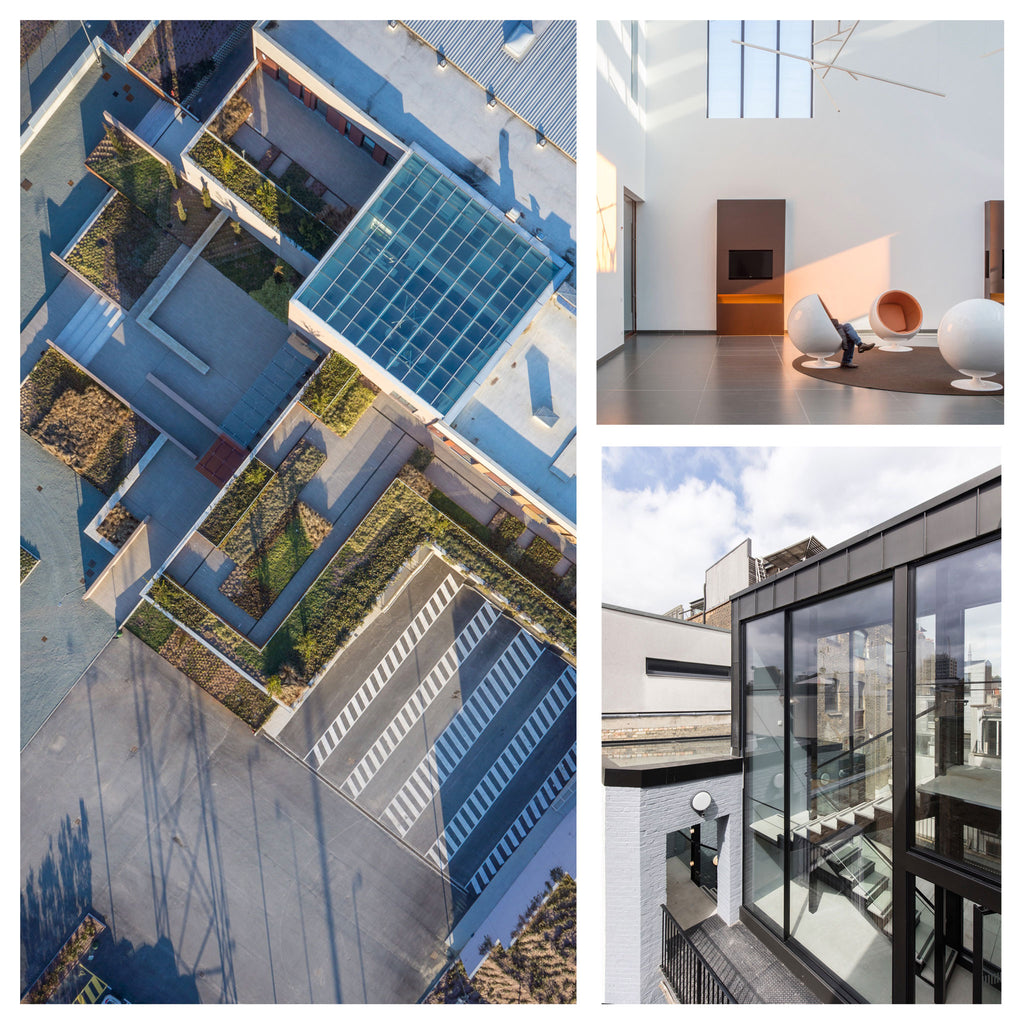
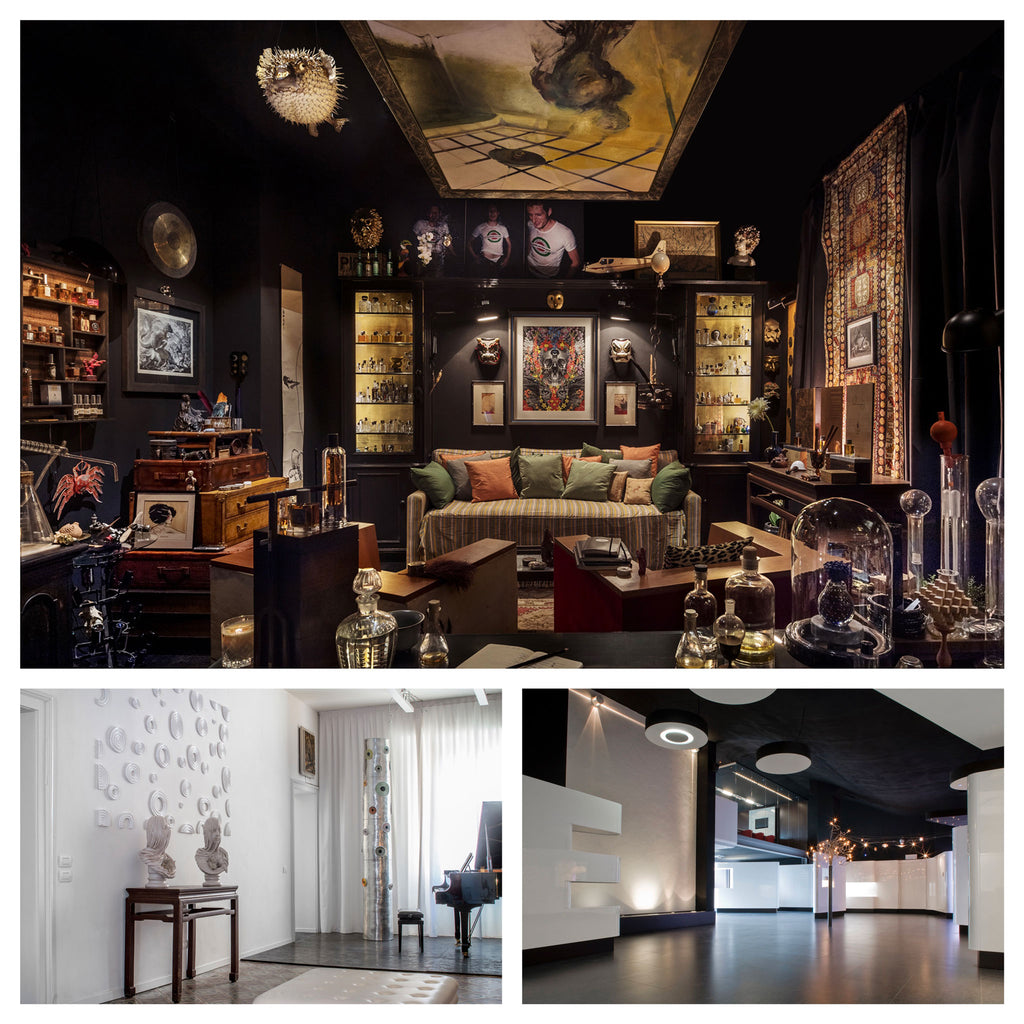
Above: Various Architectural and Interior Design Works by Antonio Gardoni
When did you become interested in perfumes and perfumery?
Eight or nine years ago. And I have to say I have never been a “perfume person”, never been that geeky about the perfumes that I wore, or genuinely interested in the subject. I got interested in perfumery because at one point I was a very interested in plants – trees, bushes and flowers. I had a “crush on nature” and tried to understand it. I got into perfumery because I was “experimenting with nature”, like chopping things up, extracting things, playing with raw materials; and eventually I really felt, okay, let’s try to simulate certain aspects of scents that nature delivers with the materials I have on hand. And that's how I started formulating, in order to reproduce an idea of nature, and I quickly moved from it because it was too difficult. For nature does it better. So I started playing with making perfumes in an unexpected way.
For years I had played with naturals, for it was easier for me to connect them with a source visually – if you picture a garden with pines, roses or grasses, etc., you could think of the materials to mix together. There were many private experiments to recreate such mini landscapes, and I called them landscapes because one of the fascinating things about architecture is abstraction. So I have realized that the “garden” I tried to create was not anymore a visual garden, but an ideal garden; furthermore, it's not anymore an ideal garden, it's a landscape, an idea, a concept.
It's very critical for me to understand the results of my private experiments. I had faced a lot of questions while studying them. I was trying to achieve a certain effect for the concept that was in my mind, and sometimes I was unable to do so. So I started studying organic chemistry from super-boring organic chemistry books, and most of the time I could find possible answers to some of my questions. While studying, you think about other ways, too, so you also learn in some non-direct ways. I'm still studying, and it’s continual process.
How long had you been experimenting with scents before you decided you wanted to publish your first perfume?
There were a couple of very early experimental “perfumes” that I had given to my family and friends. But Maai is the first official, “proper” perfume, and it was released about five years ago.
I remember when it first came out, it made a splash in social media, and of course, it was a hit! Did the positive reception surprise you?
The positive reception and reactions I received from people whom I had never heard of were a massive surprise. I really felt people were mad at liking Maai that much at the beginning! I couldn't believe it for it was really one more big experiment in my own little world. And suddenly people from all over the world started sending me e-mails, “Can I have a sample? Can I have a sample?” At the same time, I started reading things about Maai, and they were shocking – in a good way. The comments and reviews from the good ones actually helped me a lot in learning and understanding what I've done, because I wasn't that conscious about my creation process and what that perfume meant.
What is Maai about?
Well, I personally still don't know! I trust a lot of other people’s opinions on Maai. To me, Maai has something to do with the big conflict that I still have with tuberose – it’s a fight between me and tuberose and how Maai could expose certain aspects of certain smells, when they were in an interlocked play of hide-and-seek in a perfume.
When you were building Maai, had you already learned about the classic perfumery structures and used them as a reference, or have you never followed any rules or used any references?
This is a very tricky question, because if I answered “yes”, everything makes sense. If I answer “no”, it might sound like there was no ambition. But the real answer is, I actually don't know, because I didn't know that much about classic perfumes back then. I think it was almost an accident that it happened to smell like an old big chypre from the past. It was very surprising for me to find out that people reference it to perfumes of much older style. I thought I was doing something new! I don't smell that many perfumes, not because I don't want to, it just that it doesn't happen. I am interested in perfumes, but I'm not interested as well. There isn’t something that I am desperate to smell, be it a new perfume or old perfume. I mean, I can live without smelling perfumes.
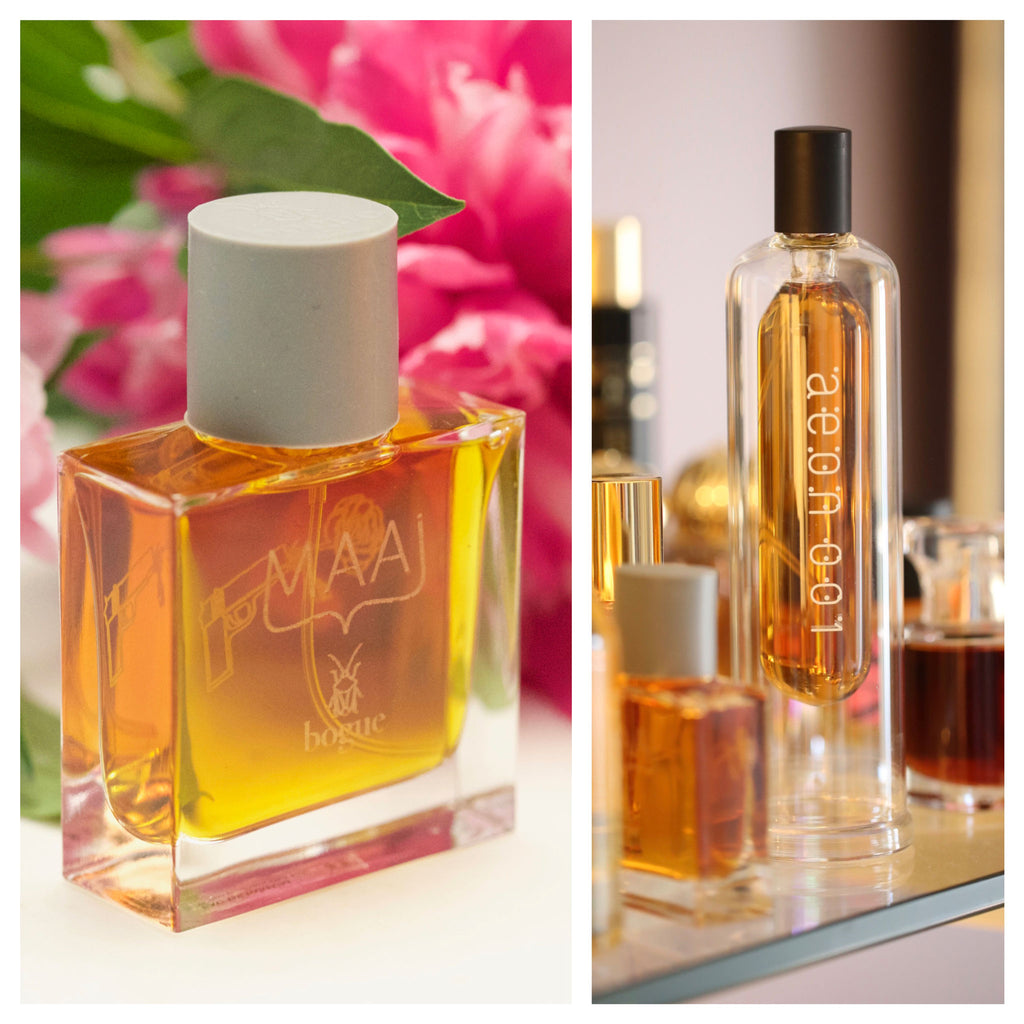
Above: Bogue Maai and Aeon 001 Perfumes
After Maai, you created AEON 001 for a different perfume company and they intentionally made the perfumer anonymous. (Ironically, this is what most perfume companies had been doing in the past, and in recent years, they are doing the exact opposite by revealing the perfumer's name.) A lot of people guessed correctly that it was your work – in fact, people often say your perfumes have a distinct style. Do you agree? How do you describe your style?
How can I not agree? I believe when people say I have a signature style, I'm not fighting against it. I mean, if you want to call it a style. We are what we are, and we can't fake it. I'm not trying to pretend to be different from what I am, so that probably applies to perfumes as well.
AEON 001 was a fantastic project. The idea of hiding the perfumer was actually mine, because I believe that the perfume itself should be stronger than its creator. I think that in this little world sometimes you are a bit too obsessed about knowing who made it, and that doesn’t help us approach the perfume itself.
And how would you describe your style?
I don't know. The only way I can describe it involves a bit of a technical process – I try to create mini clashes between each ingredient that I use. Each ingredient smells different with its counterpart, so if you use a material together with its “enemy”, and achieve a balance, you get interesting results, kind of like you use the citrus to counterbalance its worst enemy…
What's the worst enemy of the citrus?
Well, it depends. It depends on the battlefield. The worst enemy of a citrus could be a deep animalic note. It could also be a “too-generous flower”, so generous that the flower is pushing to come out, and the citrus tries to kill at the beginning but the citrus dies fast and the flower wins.
People often describe your perfumes having bombastic projection, with very long-lasting quality. What's the trick to it?
Use a lot of materials! (laughs) Essentially a high concentration of perfume! For me, anything below 20 percent is very difficult to make work. I work with a lot of naturals, and somehow they need bigger quantities to deliver a certain effect.
What about synthetic aromachemicals?
I learned a bit how to use aromachemicals, and they are absolutely functional. I love aromachemicals, but I can't say I'm using them 50/50 in any formula. With all naturals, it is like a battlefield from the 17th century – but with aromachemicals, suddenly you take on someone with a laser gun or atomic bomb. So it's really interesting and exciting for me to mix both together.
You also create bespoke perfumes for clients. Can you tell me more? Do you enjoy creating them?
That's probably what I have enjoyed the most for the past four or five years, because it's a very different job from creating and selling your own perfume., When you work with a private client on a bespoke project, you have a very intimate one-to-one relationship, and you try to learn things – first of all, from the person in front of you. And at the same time you try to liberate the person from certain prejudices and certain preconceived ideas. So it's a very challenging process, because the number of time I've been approached by people saying, “Oh, the perfume I want has to have this material, that material,” and they end up with something completely different because through the process they found out that the material or an idea of a certain perfume that they used to hate was actually a fixed idea – but experienced in a different way or challenged in a different way, it could change their mind.
Also, designing a bespoke perfume also provides me a great opportunity to experiment with materials that are too expensive to use in bigger proper productions. And each of my private clients really has given me the possibility to explore notes, materials, process, ways of doing things, and at the end, they received the most diverse perfumes for weddings, for lovers, for very famous people, or completely anonymous people. It’s so challenging, interesting, super fun – and sometimes these bespoke processes gave me inspiration for something for my own perfumes.
Occasionally I see you post photos of your non-perfumery work, such as faucet design and shop interior design on Facebook. It seems to me that you are never short of projects. Do you ever intend to take your perfumery full-time and expand the distribution network?
I think my perfume passion needs architecture to survive, not because of the financial side of things, but it provides some sort of counterbalance. Fragrance is like a piece of cloud – ephemeral and extremely difficult to be bring down and to track. But when you go inside a building that you design, you see pure, physical, heavy concrete steel structures, and that physicality creates a counterbalance.

Above: Retail Space Design and Industrial Design Works by Antoni Gardoni
I don't think I would ever leave architecture behind and make perfumery a full-time job. I don’t not even plan to expand my retail network or increase production, etc. You know, as in a formula, you try to reach a good balance of things. It doesn't mean it has to be a pleasant balance. But it's my own balance.
For me, the distribution network has always been very, very, based on personal relationships. I've been lucky enough to work with some amazing people. And I don't believe in having two or three more doors opened in order just to sell 10, 20, 30 more bottles. I know it takes time and concentration, and focus on good things to establish a good business relationship.
You have been one of the judges for the Arts and Olfaction Awards (A&O) for the past few years. How did that happen?
This happened because of Maai, essentially, again. Maai was involved in a very interesting and fun project about an old 1960’s “smell-o-vision” movie, “Scent of Mystery”. The Institute of Arts and Olfaction, together with producer Tamara Burnstock, were rereleasing it, and they tried to create a new scent for the “scent track” to the movie. In the original movie, the main female character was Elisabeth Taylor, and she wore a perfume called “Scent of Mystery” by Elsa Schiaparelli. They decided to use Maai as her perfume in the movie. And when we got in contact with the institute I met Saskia Wilson-Brown (the director of A&O). That’s how we became friends, I later got involved in the judging process.
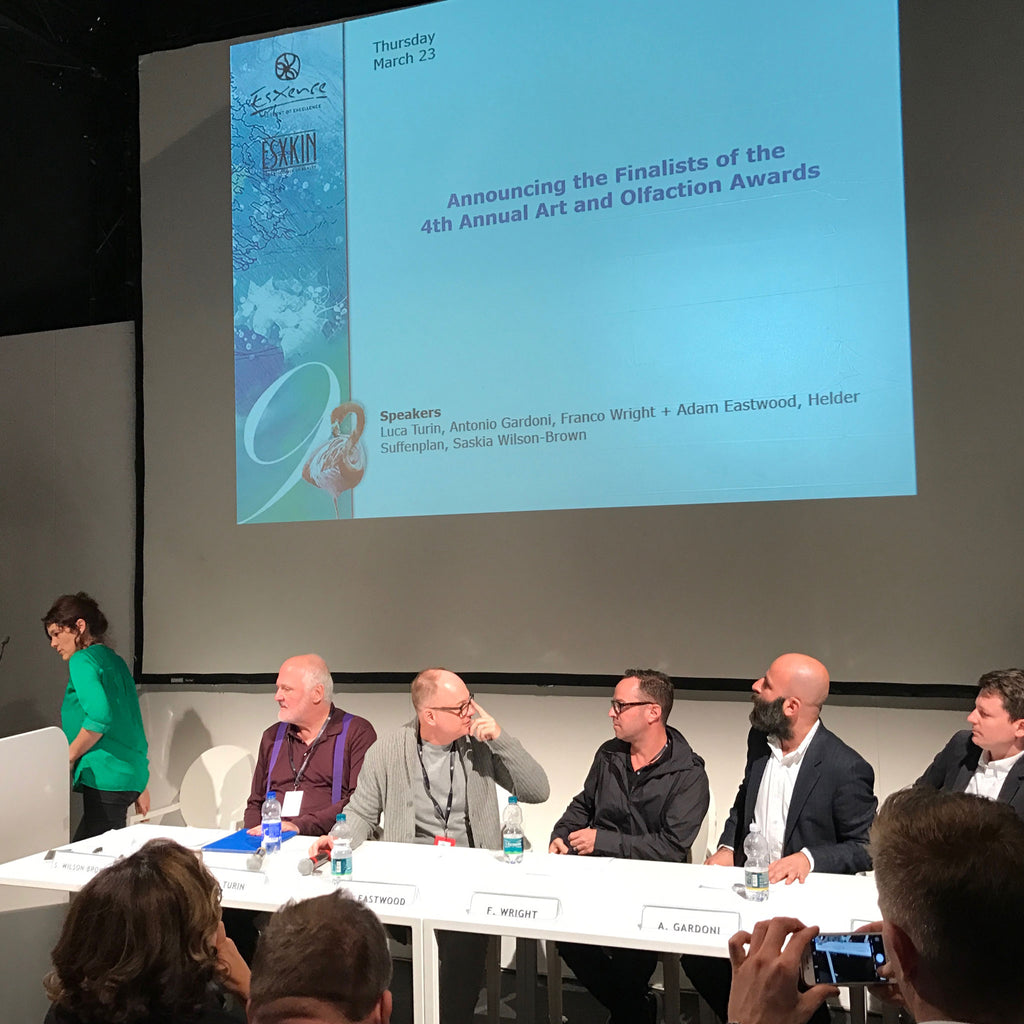
Above: At the 2017 Art and Olfaction Award Finalists Annoucement Event at Exsence, Milan Italy
What did you observe? Did you gain any insights from evaluating so many perfumes?
I did gain some experience from some other people's work. But it's an activity I don't do much on my own. Being a judge almost forces you to evaluate and smell things that you will never smell, and that's super interesting. Sometimes I really struggle to understand what I'm smelling, but I rarely smell a perfume that I find wrong. However, it’s very important for me to understand what the creator is trying to say through the perfume – some people are so soft spoken that you can almost not hear what they are saying; some people are too loud, and some people are talking in vulgar words, etc. For the past three years I've been a judge for A&O awards. There’s always something worth listening to in each perfume. So that's what I have learned. I’ve learned to listen by being a judge.
Have you come to a conclusion of what type of perfumes tend to win the award?
No idea! I've seen the most different things winning over the years. I'm so happy with the diversity and peculiarity, and, you know, when Zoologist Bat won the award (in 2016), I thought it was amazing. It was a very important thing for me, because Bat was a perfume not meant to win an award in any way. It was too extreme in certain aspects, too conceptual, too hard to experience, and it demanded a lot of process from we are used to experiencing, and sometimes difficulties are not a good thing when you want to win an award. Sometimes going on an easy way makes life easier, you know? And I think it demonstrates the possibilities of winning an A&O award are very varied. It really challenged the perception of who can win or lose. I think it's a very exciting process, and it really helps people understand new possibilities and new directions.
Let's talk about Tyrannosaurus Rex!
Finally!
I remember vividly how this project began - I first met you in 2016 during the Arts and Olfaction Award, and we exchanged our perfumes. I gave you a bottle of Bat and you gave me a bottle of Maai! About a year later, I met you again at the Milan perfume exhibition, Esxence. I jokingly told you that if I could rename a vetiver-themed perfume of yours, I would call it T-Rex, because it smelled very primal and dangerous to me. I said maybe you should develop T-Rex for Zoologist, and we both immediately laughed it off. The next day, early in the morning, you messaged me over the phone that you wanted to work on this project because it was stuck in your head. We later sat down in a restaurant and talked for hours about what it should smell like.
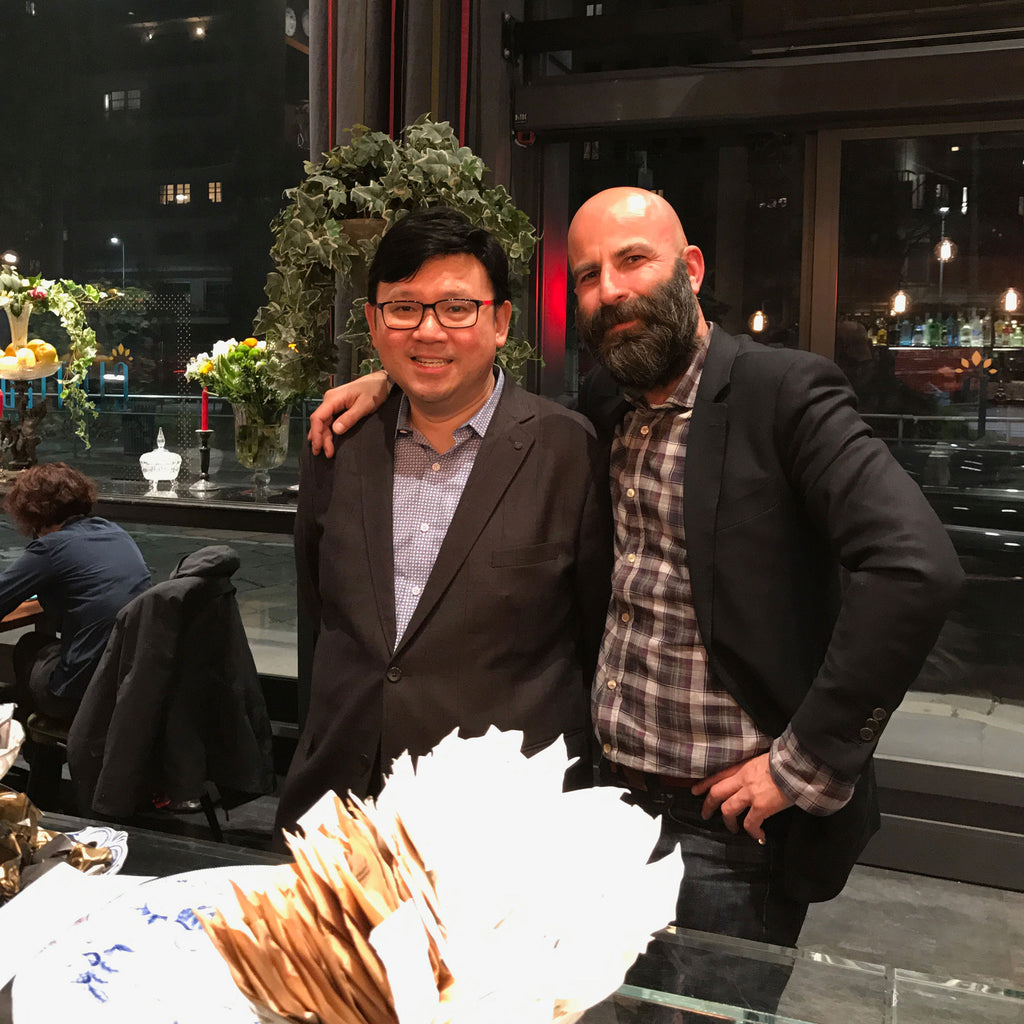
Above: Victor Wong and Antonio Gardoni (2017)
My vision of T-Rex was a loud, chaotic, primal, dangerous scent. I wanted the scent to be an olfactive version of a fantastical, colourful illustration one would find in a junior science textbook – fascinating, lots of things happening in the background like volcanic eruptions, forest fires, crazy gigantic flora and fauna, and of course, T-Rex tearing a poor victim's bloody body apart. As you might already know, I'm a very visual person, and I like to send perfumers a "mood board", or photo collage when a project begins. With that, hopefully the perfumer would take on the clues and incorporate the feelings that it evokes into their creation. Then you told me you were not a visual person when it comes to perfumery; to you, perfumes have more of a "sound" quality. Could you elaborate on that? And what does T-Rex "sound" like to you?
It is difficult to talk about perfume, because we don't have the language to properly describe scents. So there is nothing wrong about referring to images or art. To me, sound is the closest reference because it has an ephemeral presence. It starts, explodes, expands, then leaves. Doesn't matter if it is the sound of a car passing by or it's a sound from a Mozart concert. It's more about the way sound manifests itself, how it demonstrates its physicality through the vibration of air. So sometimes for me it's easier to think about the “vibrations” of a perfume in sound than images. Perfumes need a space to work – with no space, there will be no “sound”, and we will not smell anything. So they need architecture in a way, something to reverberate, like you go against the wall and jump back.
So what does T-Rex “sound” like to you?
To me, T-Rex sounds like a very gentle noise. A gentle, continuous, annoying almost, noise. It's like continuous drops of jelly substance coming down from a leaf, or blood coming down from the mouth. The sounds of swallowing, violent sounds of falling water coming down from the river into the lake, different sounds of water from a very faraway distance… it's very visual actually. (laughter)
And which ingredients did you choose to achieve that?
In T-Rex I tried to use some materials that I considered “enemies and friends”. I have used some very earthy materials like patchouli to create a thick ground, or horizontal surface. Right above the horizontal surface is some sort of a balsamic floral layer made out of very different materials like ylang ylang or champaca. It is lighter, aerial, but not light enough to go up in the sky, just light enough to go up and come down in droplets to create some sounds. When the droplets hit the ground, or muddy lake, certain materials such as smoke bounce back and evaporate, while the patchouli gets absorbed. These matters go up and down, creating a scenario of interest to me.
When I did my research on dinosaurs, I read that at their height of their existence (the Cretaceous period), plants started blooming for the very first time. I insisted that T-Rex should have a big floral accord. Did that throw your original vision of T-Rex off? Do you think we have sacrificed the ferocity of the perfume by adding florals to it?
Not at all. I actually found florals absolutely essential in T-Rex. If you think about it, we actually have no real references to use to design a perfume called T-Rex. In fact, originally I wanted to make T-Rex smell of plastic toys, because that’s the first smell we associate dinosaurs with. We rely on the studies published by scientists, but to be honest, we have no idea what flowers smelled like back then. You have no idea of what those big animals smelled like. Actually, not a single smell you can truly refer to, because that world was all gone a million years ago. So it is important to indulge in the stereotyped idea of what things you imagine would smell like, be it gigantic flowers with super-thick petals covered with dripping nectar; forest fire and exploding lava moving down volcanoes and into cracks, animals killing each other and eating gigantic leaves… but what's the smell of that leaf? What’s the smell of those flowers? What's the smell of Earth?
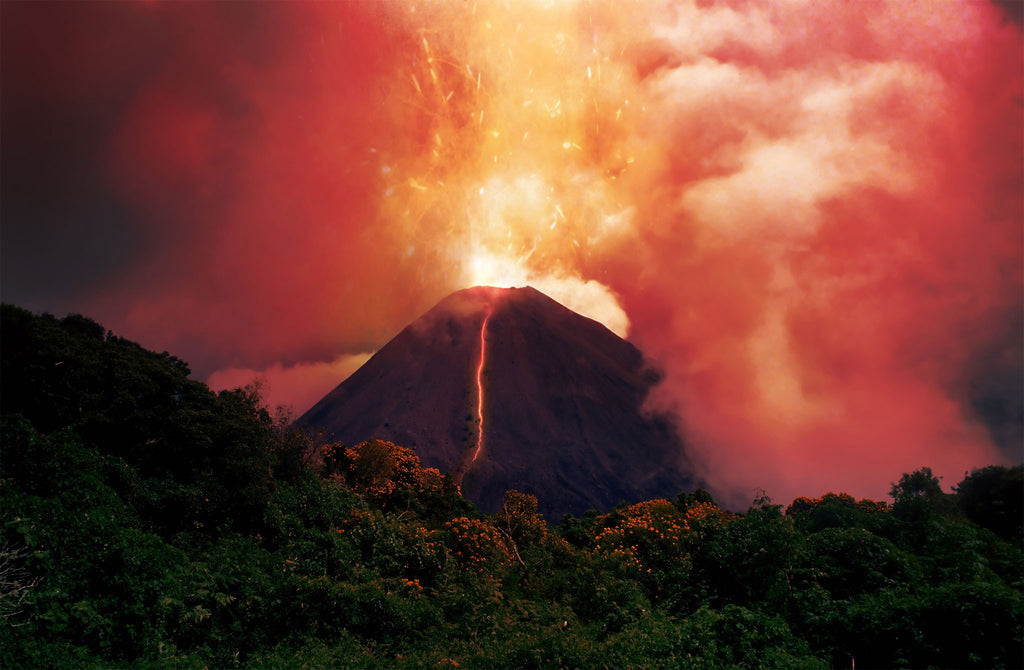
I think T-Rex needed to have all the traditional Chinese elements – metal, wood, water, fire and earth. Not that the perfume smells like Chinese medicine, but those five elements needed to be there. So there is a pungent aspect of metallic notes of blood. Some kind of flowing muddy substance to represent water, smells of smoke and fire for the volcano exploding, earth as in a moving hearth that the blood drips on. And the air during T-Rex’s time fascinates me – there should also be some aspect of the sky in it, because you always think about big trees, big animals, big earth – but can you image the sky in that period of time? It had to be completely mad! We probably had two moons crossing and clouds blocking the sun and strange rains and stones coming from down! Who knows! I mean I don't know, but probably some scientists think they do. So that's why florals didn't affect it badly at all. Actually they helped. I mean, it was obviously easier for me to picture a perfume that was very earthy and very floral in a way, but the way I use florals in T-Rex is not exactly a pleasing easy way. I believe it's showing the generality of a certain idea of the flowers in a vulgar way.
At some point during the development of T-Rex, I suggested toning down the perfume a little bit to make it less avant-garde, but more wearable. Did that compromise your original vision of what T-Rex should smell like?
I think the first version was a very interesting representation of “T-Rex”. As I have already said, this subject can only refer to itself. So how does it compare to something else? Is your face more real in a photo than in the mirror? Or is it more real when after you’ve shaved, or is it more real when someone caresses your face, or when you bang your face against the wall? I think T-Rex is still T-Rex, and it has been T-Rex all the way along. We are just representing the same thing in a different way. You can tell the same story in an hour, in two minutes or with a haiku. I know it's the same story.
I am very proud that this project is going to be the only animal in your collection that is extinct. We're dealing with an animal that is very difficult to relate to… say, you look at an alligator now. Not big enough. Look at an elephant now. Still not enough. To me, it's a very conceptual animal. It's like playing around an animal, but that animal is really just a concept. It's so distant from what we know from experience. So that was really exciting for me, because if you asked me to make a Zebra perfume and said it was interesting, I will say, whatever! You can’t argue that with a T-Rex!
What is next for you?
This summer, I am going to teach some young kids, 6-8 years old, for a couple of days. We will be playing around smells, telling stories with smells. It will be very liberating and amazing because they have no prejudice against smells. You know they can sniff their own poo and feel happy. We will have a very interesting time exploring different materials, mixing them, etc.
The school is a little place up in the mountains, north of Italy, where they do some classes on very different subjects. They asked me if I wanted to do something interesting with them on perfumes. They do classes for adults generally, but they have one week dedicated to kids. It's actually something really challenging to me, for it's not easy preparing the materials because of safety issues.
Thank you so much for your time, Antonio!
Zoologist Tyrannosaurus Rex will be released in Fall 2018.
